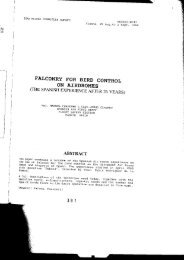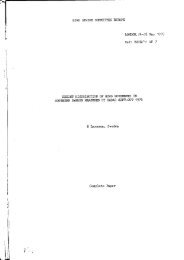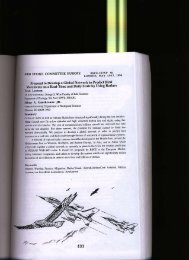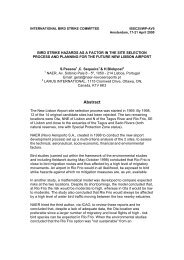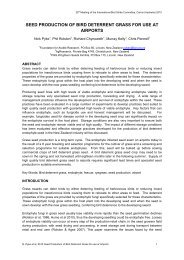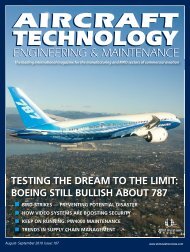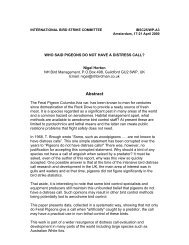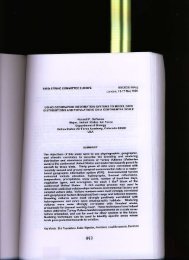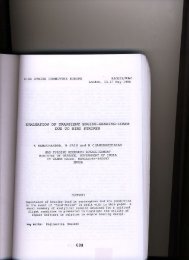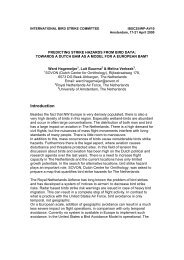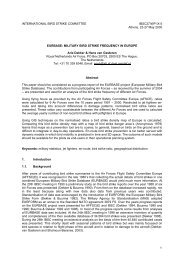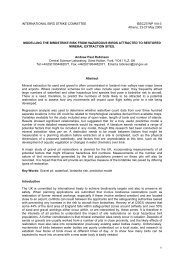Bird movements aro - International Bird Strike Committee
Bird movements aro - International Bird Strike Committee
Bird movements aro - International Bird Strike Committee
You also want an ePaper? Increase the reach of your titles
YUMPU automatically turns print PDFs into web optimized ePapers that Google loves.
adar in avoidance systems<br />
In figure 6 the curves of figure 1 are combined with attitudtnat ranges ot b rd<br />
control: en foute, <strong>aro</strong>und and on anpons. Avoiding birds in the air is difftc!h<br />
because many bird <strong>movements</strong> occur betow rhe coverage of most tong range<br />
surveilance radars {stippted) and just above the acquisition .ange of rh; visual<br />
observer (shaded). To make ir even worse. tow tevet btd fying activtry is oflen<br />
in big flocks as food rinding is a very sociat affair, especia y i; wefland a.eas<br />
where water rabte dynamics creares a ftuctuating and palchy availabitiry of<br />
food. A thorough map/calendar approach is of course the lirst srep in pianning<br />
new airpo(s or aircrait flying routes. aut this information atone is too static f;r<br />
day-to d€y bkd strike prevention. For each headache species the daity and<br />
seasonal flying partern shoutd be known. In principte a tot of bi.d activity can be<br />
predicted by a dynamic modet fed bV certain environmentat parameters, aut<br />
scientific generalizations are lsua ty not enough to predict how each species w I<br />
adapt to specific localconditions. Additionat rutes of thumb about spatiat fying<br />
behaviour in reation to wearler, topography etc. are neeneo.<br />
l. practice the onty ,rnodets,ihai do exist are very experienced b rd contro|ers<br />
gvinglheir'best profess onatjudgeme.r,_ Howevef, this iype of antictpation is<br />
primarily based on whar can be mentaty reconsrruct€d from visua observarion.<br />
This is usually imlled to rhe a rport itsetf and 10 the towest 5O meters (Buu.m.,<br />
Lensink & Linnartz 1986). Bur even he.e a big bird fock may sudenty appear.<br />
As noi all blrd controtters are eqlalty experienced and atert, and as they cannot<br />
overvrew the whole aiiport, ihere is a gap in tho markel for detecl on devices<br />
oaseo on remote sensrno such as radar.<br />
radar in avoidance systems<br />
The above mentioned gap in the marker is growing surely but s owty as rong as<br />
we are not at)re to quantify rhe bird strike risk betler and to show convincingty<br />
the amo!nr of risk reduction. Air traffic conlro ers do not wish ro accept<br />
addillonal responsibilities when the btrd information is nor very ctearty indicared<br />
and well derined. Obviousty, not every singte smaI or medium sized b rd can<br />
kept under controt. Thus, rhe equ pment shou d be abte 10 tndicate whether the<br />
amount ot bird meat in a cerlatn air vot!me exceeds a ce(ain agfeed vatue.<br />
Figufe 6 is a propos:lro reduce the many options or apptying remole senstng<br />
into three altitude/scate ctasses on the basts of rhe spaital disrribution oi b rd<br />
slrikes. ls!ggesr the fotowng terminotogy,<br />
A. 2-D on airoort bird flock deteciton Certain ground radars do have the<br />
capacity to monitor birds or cou d be adjusred 10 do so {schaefer 1969). Given<br />
the limiled range needed 6tso off-the shelve marine radars with a reptaced<br />
anlenna, to .a ow t\e bear and ircrea\e qdin, mrght be .porred. Ihe n a n<br />
p oD em 6 grou-dctLtrer r"d-cr o1, bJt sopli\r.carFd new techro,ogy is abte to<br />
solve this satisfactority.<br />
i\2,



